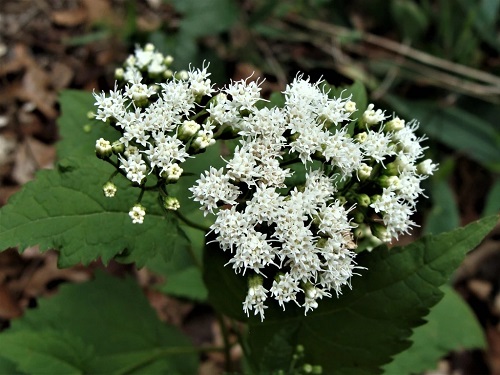There are countless poisonous plants in the world. Unless you are a specialist who can identify all the varieties, it is often difficult for owners to roam their pastures and know what to watch out for. But two of the most common poisonings in horses that owners should look out for are from white snakeroot and maple leaf ingestion.

White Snakeroot is more common in the Midwest, but it is also found growing in Northeastern states. White Snakeroot specifically causes heart damage, and an organ that can be scarred if the disease is not caught early. Depending on the severity of the scarring, a veterinarian may declare the horse unsafe to ride. Horses can show symptoms after eating the plant in just a few days or weeks, depending upon the amount ingested. Symptoms owners would see are incoordination, weakness, muscle tremors, swelling, and exercise intolerance.
Another plant poisoning in horses is red maple leaf ingestion. Fresh leaves are not a problem, but the wilting leaves are toxic. If you do have a red maple in your pasture, be sure to remove fallen branches before the leaves on them start to wilt. Clinical signs of red maple poisoning are red urine (because the horse’s red blood cells rupture and hemoglobin passes in the urine), weakness due to anemia (a decreased amount of oxygen carrying red blood cells), and icterus that can be seen on the gums.
To prevent any type of plant poisoning on your farm owners should walk the pasture and send any suspicious plants to your local extension office. In general, many horses know not to eat certain plants, but that is not always true. For example, if you spray herbicide on the field, that in and of itself may not be toxic, but it does make many poisonous plants more palatable. This is because as the plant starts to die it becomes sweeter, and many horses enjoy that taste.
There are over 2,000 toxic plant species, but the growing patterns are very regional. If you suspect your horse has eaten a poisonous plant, call your veterinarian as soon as possible and try to identify the plant. Even if you cannot classify the plant, a veterinarian may be able to treat your horse symptomatically depending on the animal’s clinical signs. But the sooner you can treat it, the better the prognosis. For more information about toxic plants, please contact your veterinarian.
Provided by the University of Illinois College of Veterinary Medicine
Creatures Corner Fun Facts
Quarter Horses are said to be able to sprint at almost 50 miles per hour. Thoroughbreds race longer distances, and often win races going 35- 40 miles per hour.
The Greatest Load Ever Pulled was by a Shire horse named Vulcan, who pulled an incredible 29 tons, when he was measured in 1924 with a “dynamometer”, an instrument used to measure power. Two Shire horses then pulled a maximum that registered on the dynamometer of over 50 tons.
The shortest word denoting “a horse” is “Uk “in the language of Mongolian nomads. The longest one “Okvilauparaklamarukoallunaklanata” was used by Indians of Peruvian tribe Micran. It approximately denotes “Bold guanaco of a white human who came from the sea”.
In 1920 the first U.S. Cavalry Mounted Service Cup race averaged 60 miles/day for five days, carrying up to 245 lb. of rider and gear.
It takes about three days for a horse to digest one oat.
There are an estimated 60 75 million horses in the world.
Related Articles & Free Email Newsletter Sign Up
How Horses Sleep and Why it’s Important That They Do
How to Maintain a Healthy Tail on a Horse
The Akhal Teke Horse is One of the Most Unique Breeds in the World


Comment here